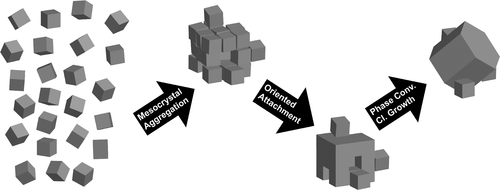当前位置:
X-MOL 学术
›
Chem. Mater.
›
论文详情
Our official English website, www.x-mol.net, welcomes your
feedback! (Note: you will need to create a separate account there.)
A Mechanistic Understanding of Nonclassical Crystal Growth in Hydrothermally Synthesized Sodium Yttrium Fluoride Nanowires
Chemistry of Materials ( IF 7.2 ) Pub Date : 2020-02-26 , DOI: 10.1021/acs.chemmater.9b04076 Alexander B. Bard 1 , Xuezhe Zhou 2 , Xiaojing Xia 3 , Guomin Zhu 2, 4 , Matthew B. Lim 2 , Seung Min Kim 5 , Matthew C. Johnson 6 , Justin M. Kollman 6 , Matthew A. Marcus 7 , Steven R. Spurgeon 8 , Daniel E. Perea 9 , Arun Devaraj 4 , Jaehun Chun 4 , James J. De Yoreo 1, 2, 4 , Peter J. Pauzauskie 1, 2, 4
Chemistry of Materials ( IF 7.2 ) Pub Date : 2020-02-26 , DOI: 10.1021/acs.chemmater.9b04076 Alexander B. Bard 1 , Xuezhe Zhou 2 , Xiaojing Xia 3 , Guomin Zhu 2, 4 , Matthew B. Lim 2 , Seung Min Kim 5 , Matthew C. Johnson 6 , Justin M. Kollman 6 , Matthew A. Marcus 7 , Steven R. Spurgeon 8 , Daniel E. Perea 9 , Arun Devaraj 4 , Jaehun Chun 4 , James J. De Yoreo 1, 2, 4 , Peter J. Pauzauskie 1, 2, 4
Affiliation

|
Sodium yttrium fluoride (NaYF4) is an important upconverting material with many potential uses in chemistry, materials science, and biology, which can be synthesized hydrothermally in both cubic (α) and hexagonal (β) crystallographic polymorphs. Understanding the mechanisms underlying the phase conversion between the cubic and hexagonal polymorphs is of great interest to help inform future synthetic efforts, for example in the design of atomically precise quantum materials with well-defined sizes and morphologies. In this work, we use a combination of analytical transmission electron microscopy (TEM), scanning transmission electron microscopy (STEM), powder X-ray diffraction (XRD), in situ liquid cell TEM, atom probe tomography (APT), and extended X-ray absorption fine structure (EXAFS) measurements to show that the hexagonal NaYF4 nanowires form through a nonclassical crystal growth mechanism involving the formation and subsequent oriented attachment of mesocrystals consisting of cubic (α) phase units. EXAFS measurements also suggest that substitutional Yb3+ point defects within NaYF4 are distributed evenly throughout the crystal lattice without clustering and also that they may exhibit selective substitution into one of the two possible trivalent yttrium sites in the unit cell for hydrothermally synthesized β-NaYF4.
中文翻译:

水热合成氟化钇钇纳米线中非经典晶体生长的机理理解。
氟化钇钇(NaYF 4)是一种重要的上转换材料,在化学,材料科学和生物学中具有许多潜在用途,可以水热合成立方(α)和六角形(β)晶体多晶型物。理解立方和六边形多晶型物之间的相变机理很重要,有助于为将来的合成工作提供信息,例如在设计具有明确定义的尺寸和形貌的原子精确量子材料时。在这项工作中,我们结合使用了分析透射电子显微镜(TEM),扫描透射电子显微镜(STEM),粉末X射线衍射(XRD),原位液池TEM,原子探针层析成像(APT)和扩展X射线吸收精细结构(EXAFS)测量显示六角形的NaYF 4纳米线是通过非经典的晶体生长机制形成的,该机制涉及由立方(α)相单元组成的介晶的形成和随后的定向附着。EXAFS测量还表明,NaYF 4中的取代Yb 3+点缺陷均匀分布在整个晶格中,而没有聚集,并且对于水热合成的β-NaYF,它们可能表现出选择性取代进入晶胞中两个可能的三价钇位点之一的可能性。4。
更新日期:2020-02-26
中文翻译:

水热合成氟化钇钇纳米线中非经典晶体生长的机理理解。
氟化钇钇(NaYF 4)是一种重要的上转换材料,在化学,材料科学和生物学中具有许多潜在用途,可以水热合成立方(α)和六角形(β)晶体多晶型物。理解立方和六边形多晶型物之间的相变机理很重要,有助于为将来的合成工作提供信息,例如在设计具有明确定义的尺寸和形貌的原子精确量子材料时。在这项工作中,我们结合使用了分析透射电子显微镜(TEM),扫描透射电子显微镜(STEM),粉末X射线衍射(XRD),原位液池TEM,原子探针层析成像(APT)和扩展X射线吸收精细结构(EXAFS)测量显示六角形的NaYF 4纳米线是通过非经典的晶体生长机制形成的,该机制涉及由立方(α)相单元组成的介晶的形成和随后的定向附着。EXAFS测量还表明,NaYF 4中的取代Yb 3+点缺陷均匀分布在整个晶格中,而没有聚集,并且对于水热合成的β-NaYF,它们可能表现出选择性取代进入晶胞中两个可能的三价钇位点之一的可能性。4。











































 京公网安备 11010802027423号
京公网安备 11010802027423号